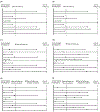Accuracy loss due to selection bias in cohort studies with left truncation
- PMID: 23930785
- PMCID: PMC6151356
- DOI: 10.1111/ppe.12073
Accuracy loss due to selection bias in cohort studies with left truncation
Abstract
Background: Selection is a common problem in paediatric and perinatal epidemiology, and truncation can be thought of as missing person time that can result in selection bias. Left truncation, also known as late or staggered entry, may induce selection bias and/or adversely affect precision. There are two kinds of left truncation: fixed left truncation where the start of follow-up is initiated at a set time, and variable left truncation where follow-up begins at a stochastically varying time-point.
Methods: Using data from a time-to-pregnancy study, augmented by a simulation study, we demonstrate the effects of fixed and variable truncation on estimates of the hazard ratio.
Results: First, fixed or variable non-differential left truncation results in a loss of precision. Fixed or variable differential left truncation results in a bias either towards or away from the null as well as a loss of precision. The extent and direction of this bias is a function of the size and direction of the association between exposure and outcome, and occurs in common scenarios and under a wide range of conditions.
Conclusions: As demonstrated in simulation studies, selection bias due to left truncation could have a serious impact on inferences, especially in the case of fixed or variable differential left truncation. When present in epidemiologic studies, proper accounting for left truncation is just as important as proper accounting for right censoring.
Keywords: Selection bias; fixed left truncation; variable left truncation.
© 2013 John Wiley & Sons Ltd.
Figures




References
-
- Flanders WD, Klein M. Properties of 2 counterfactual effect definitions of a point exposure. Epidemiology 2007; 18:453–460. - PubMed
-
- Response Greenland S. and follow-up bias in cohort studies. American Journal of Epidemiology 1977; 106:184–187. - PubMed
-
- Kleinbaum DG, Morgenstern H, Kupper LL. Selection bias in epidemiologic studies. American Journal of Epidemiology 1981; 113:452–463. - PubMed
-
- Sackett DL. Bias in analytic research. Journal of Chronic Disease 1979; 32:51–63. - PubMed
-
- Hernan MA, Hernandez-Diaz S, Robins JM. A structural approach to selection bias. Epidemiology 2004; 15:615–625. - PubMed
MeSH terms
Grants and funding
LinkOut - more resources
Full Text Sources
Other Literature Sources
Research Materials

